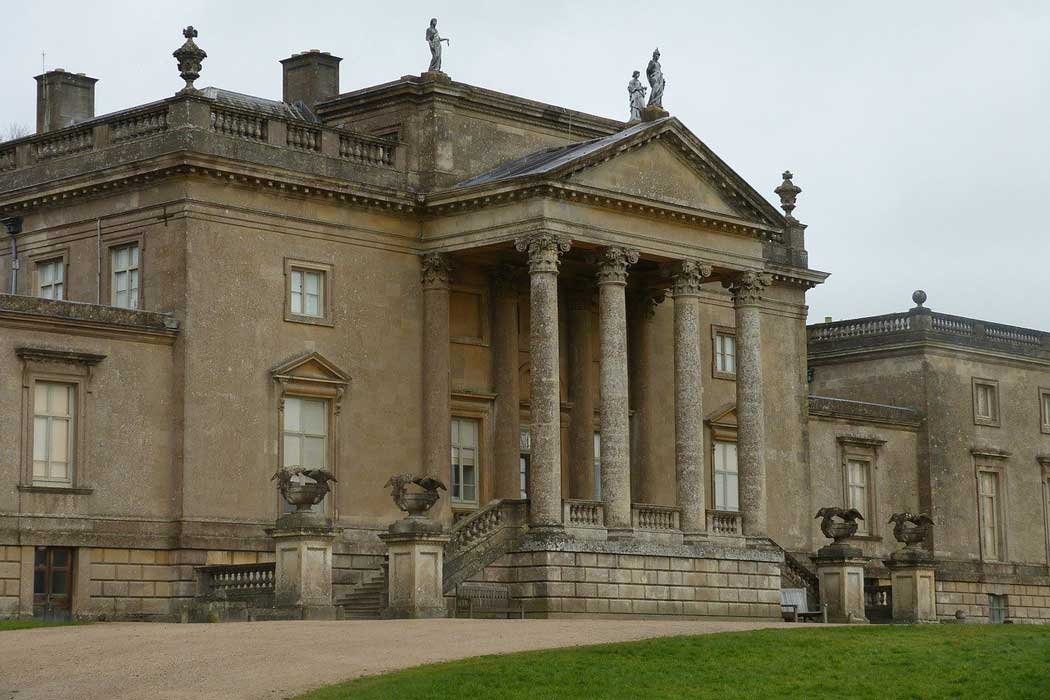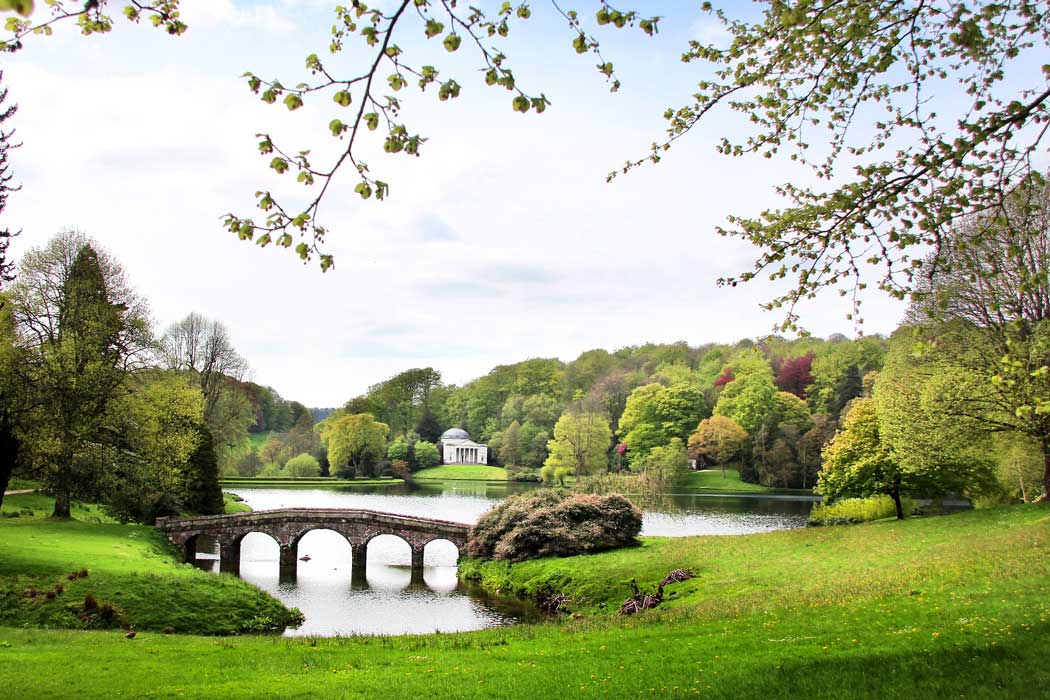Stourhead House and Gardens are the main attractions on the Stourhead estate, which also includes the village of Stourton.
The 1,072ha (2,650 acre) estate was the home of the Stourton family from the 13th to the 18th centuries. In 1714 it was sold to Sir Thomas Meres and three years later it was sold to Henry Hoare and it remained in the Hoare family until 1946 when it was given to the National Trust.
The Hoares are largely responsible for what you see today. Shortly after the estate was acquired by Henry Hoare, he set about building a new house in the Palladian style and around 20 years later Henry Hoare II started work landscaping the gardens.
What to see at Stourhead House and Gardens
There is quite a lot to see at Stourhead House and Gardens. Although the Palladian-style house is the main attraction, there are several other notable buildings on the estate that can be visited while walking around the lake in Stourhead’s extensive gardens.
Stourhead House
The house was designed by Colen Campbell and built by Nathaniel Ireson in the early 1720s. Campbell was a prominent Scottish architect noted as a pioneer of the Georgian style who is also responsible for remodelling the facade of Burlington House in London, which is now occupied by the Royal Academy of Arts.
The main floor of the house is open to the public and this includes the Regency library, original Chippendale furniture and the mansion’s Italian Room (also known as the Painted Alcove), which is home to Henry Hoare’s art collection, featuring an excellent array of hand-coloured prints.

Stourhead Gardens
The gardens were laid out between 1741 and 1780 based on a design by Henry Hoare II. It is a typical 18th-century design, heavily influenced by the Italian landscape and featuring an artificial lake. It is considered by many to be the most beautiful landscape garden to be designed in the 18th century.
The Bristol High Cross near the entrance to the estate is one of the first things that visitors to Stourhead see. It was originally erected in the centre of Bristol in 1373 to commemorate Bristol being made a county independent of Somerset or Gloucestershire and it was rebuilt in 1663 to add a third tier. The cross was moved to Stourhead in 1765 as it was considered an obstruction to traffic in Bristol.
There are several other buildings and monuments on the estate including three temples and a tower. These are essentially follies designed to enhance the landscape but they remain architecturally-significant and four of them (the Palladian Bridge, the Pantheon, the Temple of Apollo and King Alfred’s Tower) are Grade I-listed buildings. The most significant of these were designed by Henry Flitcroft.
The Pantheon is probably the most important visual feature of the gardens at Stourhead and it features sculpture and friezes in the classical Italian style. The Temples of Apollo and Flora are placed in a similar manner to frame the landscape.
The grotto is a domed chamber built to resemble a cave and it features several classical-style sculptures. The National Trust corporate typeface is based on the inscription of a quotation by Alexander Pope in the grotto.
The Palladian Bridge was built in 1762 as an ornamental feature and it was inspired by the work of the 16th-century Italian architect Palladio, from which the Palladian architectural style takes its name.
The Ice House is another building that you can visit while walking around the lake. However, it was not built as a decorative feature but rather as a practical way to keep ice frozen during the Georgian era.
The best way to see the gardens is to take the 1–2-hour walk around the lake in an anti-clockwise fashion.

King Alfred’s Tower
The 50m- (164 ft)-high King Alfred’s Tower is a brick folly designed in 1772. The tower, also known as either the Folly of King Alfred the Great or simply as Stourton Tower, sits atop Kingsettle Hill at the western edge of the estate just across the Somerset border. It resembles a tall, narrow, castle with a crenellated parapet and visitors can climb the 205-step spiral staircase to the top where they are awarded by views of the surrounding countryside.
The tower is a 5.6km- (3½ mile)-drive from the main entrance to the gardens. It takes around 10-minutes to drive here and you can also walk there in a little over an hour.
![Visitors to King Alfred’s Tower are rewarded by breathtaking views of the surrounding countryside, as long as the 205-step climb doesn’t take their breath away first. (Photo: Jürgen Matern [CC BY-SA 3.0])](https://englandrover.com/wp-content/uploads/2019/12/king-afreds-tower.jpg)
Visiting Stourhead House and Gardens
Stourhead House and Gardens are located next to the village of Stourton, which is in the southwestern corner of Wiltshire, around 14km (8½ miles) south of Frome.
If you want to come by public transport, there is only one bus a week (on Wednesdays) that comes into Stourton. However, more frequent buses stop near the Bell and Crown in Zeals, which is 2.4km (1½ miles) south of Stourton. From the bus stop in Zeals, it is around a half-hour walk along Bells Lane to Stourton.
Zeals is served by Salisbury Reds route 25, which runs between Salisbury and Wincanton, and South West Coaches route X4, which goes to Gillingham and Sturminster Newton. In both instances, the buses are not particularly frequent with only two or three buses per day.
There are no bus services between the Stourhead House and King Alfred’s Tower so you’ll need to either drive (or take a 1½-hour walk) if you want to see both sites.
Because of poor access by public transport, Stourhead is much better suited if you’re driving and parking is available in Stourton and at King Alfred’s Tower. The main National Trust car park costs £4 per day but it is free for National Trust members.
The admission charge is quite pricey but entry is free for National Trust members.
During the main season (March to October), there is a shuttle bus that takes visitors from the visitor reception to the main entrance of the gardens and Stourhead House.
The central part of the garden that is accessible via the lakeside footpath is open year-round. However, the house closes a few days before Christmas and does not reoen until early March.
King Alfred’s Tower is closed between November and April and it is only open on weekends during the rest of the year. Because of its location away from the main attractions, the tower is less crowded, but you also need to allow time to drive (or walk) there.
There are guided walks of the gardens at 11am and 1.30pm daily between March and October.
It is a great place to visit at any time of the year, although many people come in springtime when the rhododendrons are in bloom, in early summer to see the azaleas and in autumn for the stunning colours.
At Christmas time there is a spectacular light display with over 100,000 pea lights and a laser garden, however, there is an extra charge to see the light display and food and drink can be overpriced during these nighttime events.
There are several places to eat at Stourhead including the National Trust-operated restaurant and the local pub, the Spread Eagle Inn.
Most visitors spend between two and three hours, although you can easily spend half a day here. It can take two hours to take the walk around the lake (allowing time to look at the buildings and monuments along the way) and you should also allow extra time for a picnic on the grounds or lunch at the village pub.


There are no comments yet.